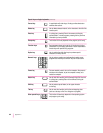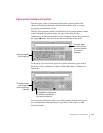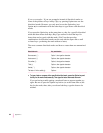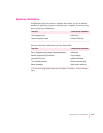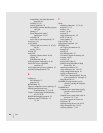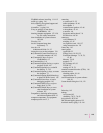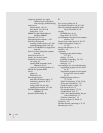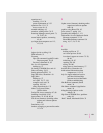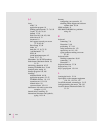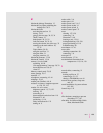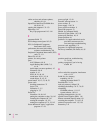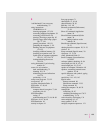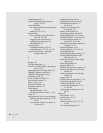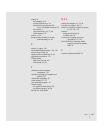
diagnosing problems. See Apple-
authorized service providers;
error messages; troubleshooting
dialog boxes
Custom Install 110, 112
Easy Install 104, 107–108
Energy Star 11, 19
DIMMs. See Dual Inline Memory
Modules (DIMMs)
dim screen 20, 72, 122
disconnecting the computer 3, 120
Disk First Aid program
installing system software 103, 106
repairing damaged disks 100–101
disks. See CD-ROM discs; floppy disks;
hard disk
Disk Tools disk, starting the computer
from 96
disk with an X icon 74
display. See monitor; screen
documents. See also files
can’t open 82
opening DOS documents on the
Macintosh 82, 83
saving if you’re having trouble 69
DRAM. See dynamic RAM
drivers
printer 91
SCSI device 49
Drive Setup program
hard disk icon doesn’t appear 75
initializing a hard disk 95, 97
overview 53
testing a hard disk 99–100
updating the hard disk 103, 106
Dual Inline Memory Modules
(DIMMs) 50
Dynamic RAM, adding 50
E
Easy Access, turning off 81
Easy Install dialog box 104, 107–108
Eject CD command (AppleCD Audio
Player File menu) 61, 85
ejecting
CD-ROM discs 61, 85
floppy disks 76–77, 126
electromagnetic emissions from computer
monitors 119
Energy Saver control panel 19–20, 122
energy-saving options, setting 11,
19, 122
Energy Star dialog box 11, 19
Enter key 142
equipment
arranging to prevent discomfort
117–118
cleaning 127–129
guidelines for handling 121–125
illustration 2, 40–41
setting up 1–8
error messages. See also troubleshooting
“Application program can’t be found”
58, 82
“Application program can’t be opened
because a file can’t be found”
58, 83
blinking question mark icon
73–74, 102
“bomb” icon/message 67, 69, 79, 89
“Can’t open a document...” 82
“Could not create a socket” 52
disk with an X icon 74
“Not enough memory” 58, 78
“sad Macintosh” icon 75
“This is not a Macintosh disk: Do you
want to initialize it” 87
“Unable to locate host” 52
what to do about 67, 68–69, 79
Escape key 142
Ethernet network, connecting to 51–52
Ethernet ports 40, 41
150
Index



